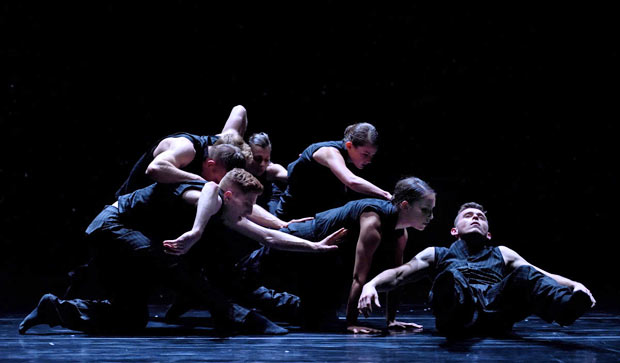
© Michael Slobodian. (Click image for larger version)
Ballet BC
16+ a room, Solo Echo, Bill
★★★✰✰
New York, Joyce Theater
3 June 2016
balletbc.com
www.joyce.org
Absence of Color
Have you ever left a performance of contemporary ballet desperate for some color, some light, some human warmth? Such was the audience’s lot this week at the Joyce Theater, where the Canadian company Ballet BC offered a trio of recent works. Recent, but not that recent. It was curious to see how dated many of the ideas, only three or four years old, already felt, how clearly they revealed the powerful influence of a mentor rather than a purely personal expression. Every piece was set in shades of black and gray; in all three, the dancers’ expressions were numb, the lighting stark and vertical, the background inky-dark.
On the somewhat brighter side, the evening consisted of works by three female choreographers, something one hopes will become more common as more women take their rightful place at the front of the studio. Emily Molnar, one of the three, is also the company’s artistic director. She is a former member of both the National Ballet of Canada and the Ballet Frankfurt, under the direction of William Forsythe. Sharon Eyal, born in Jerusalem, was a longtime member of the Batsheva Dance Company under the choreographer Ohad Naharin, and also Batsheva’s house choreographer for seven years. Crystal Pite, the best known of the three, was, like Molnar, a member of Ballet Frankfurt, before starting her own company, Kidd Pivot, in Canada, and choreographing for companies around the world.

© Michael Slobodian. (Click image for larger version
Only Pite’s Solo Echo, from 2012, seemed to break free from its overarching style to suggest an inner life, relationships among the dancers and between the dancers and the music, and perhaps a larger idea. Inspired by a Mark Strand poem about death (“Lines for Winter”), it ends with a powerful image of bodies slipping through the arms of their partners in quick succession. There are shadow-images – a dancer on the floor mirroring the movements of another, who is vertical – as well as waves, chain reactions, and a chilling landscape of bodies frozen in contorted shapes, like the figures at Pompeii.
Pite is extremely skillful at sculpting the body, drawing attention to its curves and articulations; often she links several bodies together, creating a multi-headed-and-limbed creature that moves as one, expands, contracts, palpitates. Sometimes these ideas come across as mere special effects, the physical equivalent of CGI, but they are nevertheless evocative. The viewer is moved by them as he might be by observing the knotted back muscles in one of Rodin’s wrestlers. The strain and effort elicits a drama of its own. The music that accompanies Solo Echo, movements from two Brahms cello sonatas, isn’t linked to the movement in particularly interesting ways, but does add a dimension of emotion and dynamics to the dancers’ interactions, something lacking in the other two works. Snow falls at the back of the stage, creating a decorative effect.

© Chris Randle. (Click image for larger version)
This was the highpoint of the evening. Molnar’s 16+ a room, set to an industrial soundscore by Dirk P. Haubrich, was an arid exercise in Forsythe-like technique, with off-balance tilts, buckling legs, and hyperextended arms galore. (As in the Pite, there was a lot of running and sliding from left to right and from right to left.) Again, the dancers were dressed in black, murkily lit from above and nearly undistinguishable. The women wore toe shoes, which they used as an extension of their feet, the better to tilt and slide. (The men were in socks.) Ensembles were punctuated by solos and pas de deux in which nothing was held or shown for long enough to register – partnering as pure process. Which is fine, as far as it goes, but eventually leads to sameness. Every so often a dancer would hold up a sign that read “this is a beginning” or “this is not the end.” Unsurprisingly, the latter sign made its final appearance just as the curtain was descending…

© Chris Randle. (Click image for larger version)
Bill, by Eyal, began more intriguingly, with a single dancer, clad in a flesh-colored body-stocking, sprinkled in ash-gray dust, moving with amoeba-like grace, a combination of extreme ballet adagio technique and the low-to-the-ground shape-shifting typical of Gaga, the movement technique developed by Ohad Naharin. The extreme twists, turned-in-knees, outstretched fingers, and splayed ribs, are all strangely beautiful, at least for a while. But the piece eventually devolves into a mind-numbing zombie-like dance in which bodies squirm and twitch to an inexorable and inescapable electronic pulse. There is something deadening, even totalitarian about the dancers’ faceless obedience to the beat. The style suggests an erasure of identity, difference, and individual will. This is one dance party I hope I’m never invited to. One can’t help but think that these dancers – strong, flexible, and deeply committed – deserve more.
As does the audience: more variety, more freedom and perhaps even a hint of color.












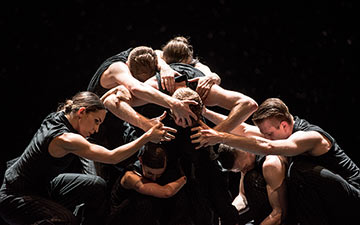
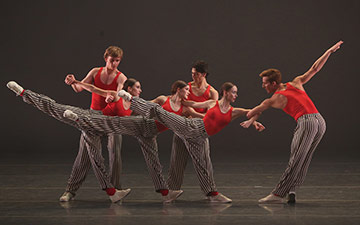
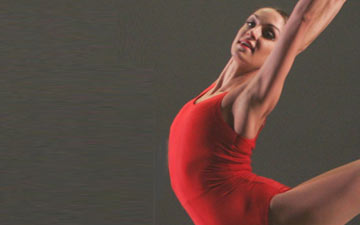

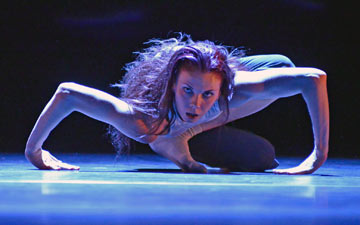
You must be logged in to post a comment.